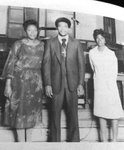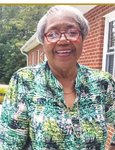

Editor’s note: Annie Taylor McCrimmon is the co-chairperson of the Chatham 250 Historical Content group, which is part of the larger effort to celebrate the 250th anniversary of Chatham’s founding. In this story, she shares the committee’s need to collect histories of Chatham’s churches and faith communities and the story of her own church’s founding.
Chatham County is celebrating 250 years of history this year. Over the last several months, a community-led planning effort has been under way to prepare a year of celebrations to commemorate this exciting occasion for the past, present and future residents of Chatham County.
Chatham 250 has more than 70 volunteers involved, representing folks and organizations from various professions and life experiences to showcase Chatham’s unique and inspiring history, focusing on the last 50 years. Their virtual collaborations over the last several months have led to an offering of Chatham’s best historical recounting in the areas of Agriculture, Creative Arts, Diversity and Community, Growth and Change, Natural Environment and Historical Content.
I chose to participate in the area of Historical Content because my interest lies in highlighting the history of Chatham’s churches and communities.
For many years, in every arena I find myself, I am encouraging folks to make sure they have written down their histories. Our lives consist of any number of memories and experiences we should chronicle. I encouraged our church, Taylors Chapel Missionary Baptist (Rev. Wm. Eugene Staton, pastor) to celebrate the history of our annual homecoming and revival services this past August. The pandemic, which has instructed us all in how to live differently, was preventing us from having the traditional program. We agreed to incorporate a commemorative program containing the history of how we went from hosting an annual revival to hosting an annual homecoming and revival. The focus was on the history of the northern migrations of African Americans and how this history led us to host an annual homecoming at our church.
Our church anniversary is celebrated annually the second Sunday in November. However, the pandemic still had us holding drive-up and live-streaming worship. We agreed to prepare another commemorative booklet. This booklet commemorated our 141st year of existence, but it featured memories of church members who have passed away since our last church anniversary. Family members provided photos of their deceased loved ones with a sharing of how this loss has affected them. They included words of comfort to others. These booklets are just further presentations of our history.
Church and Community history is the story of the people. It tells what we did, when we did it and how our today is a testament of how well we did in our church and community building. Many of Chatham’s leaders grew up in these churches and communities.
These histories tell such important stories, so we have created the “Churches and Communities Project” as part of the Chatham 250 celebrations to do our best effort to collect these histories.
Over the next few weeks, we are inviting Chatham’s churches and other places of worship to share their church and community histories with us. We are excited about the prospect of being able to share with each other, as churches and communities, who we are, where we are and who we have become.
If you’d like to share your church and community’s history to this project, please either:
• Complete this brief online survey: https://bit.ly/churchandcommunity
• Email chatham250thanniversary@gmail.com
• Call Hilary Pollan, Chatham 250 Project Manager, at 919-545-8408 for more information
I’d like to share some of the history of my church — Taylors Chapel Missionary Baptist — with all of you. I hope you’ll see that these are the stories of Chatham people and Chatham communities.
In the early 1800s, Blacks in North Carolina were forbidden to preach, exhort, or teach in any prayer meeting or other association for worship where slaves of different families were gathered together.
The congregation of Taylors Chapel Missionary Baptist Church began its worship as most Blacks did in the 1800s, secretly meeting wherever they could congregate and worship and praise in peace. Later, they were permitted to worship from the balcony of the all-white Mays Chapel Church located in our community.
In 1879, Jack and Margaret Taylor took a very bold step when they bargained, sold, and conveyed three quarters of an acre of land to the trustees of Taylors Chapel Church for the construction of a church house. Their signatures were witnessed by Henry Dowd(y) and Charles Watson, because they could not sign their names. (For many years it was illegal to teach Blacks to read or write.)
The original Taylors Chapel Church, located on Taylors Chapel Road, was a one-room building without any modern amenities. It had a very small pastor’s office located to the right of the pulpit. The church was heated by a wood-burning stove. It had no indoor plumbing; the bathroom was an outhouse, out back. The church originally faced the woods; however, in the 1940s it was turned to face the roadway to make it more accessible.
Taylors Chapel Missionary Baptist Church has had 14 pastors over its life of 141 years. Rev. Dr. Gregory T. Headen was called to pastor in 1971. He was 19 years old and a student at Pembroke University. It was under his leadership that plans for a new edifice were made and construction started. Rev. Headen spearheaded the acquisition of an additional five acres of land, on which the current church sits. Rev. Willie Barton and his lovely wife, Lillian would see this vision to fruition. Rev. Terry Jones, who was being mentored by Rev. Barton, and his lovely wife, Vondra and daughters would share this ministry.
Rev. Headen led Taylors Chapel Church in a Centennial celebration in 1979. The two-day affair started on Saturday afternoon, Nov. 3, 1979, at J.S. Waters School with a banquet in the cafeteria and the second part of the celebration was held on Sunday, Nov. 11, at the church.
Rev. Headen would become Chatham County’s first black school board member. He also spent part of his career as Chatham County’s Housing Authority manager.
That’s part of our history. We hope you will accept our invitation to share your history with the rest of Chatham County.
Annie Taylor McCrimmon serves as co-chairperson of the Chatham 250 Historical Content Committee and Churches and Communities Project, with Ernest Dollar serving as the other co-chairperson. Other committee members include Cicily McCrimmon, Delphine Taylor Womack, Quentin Murray, Jane Wrenn, Maria Soto, Cindy Schmidt, Madison Fragnito and Hilary Pollan.